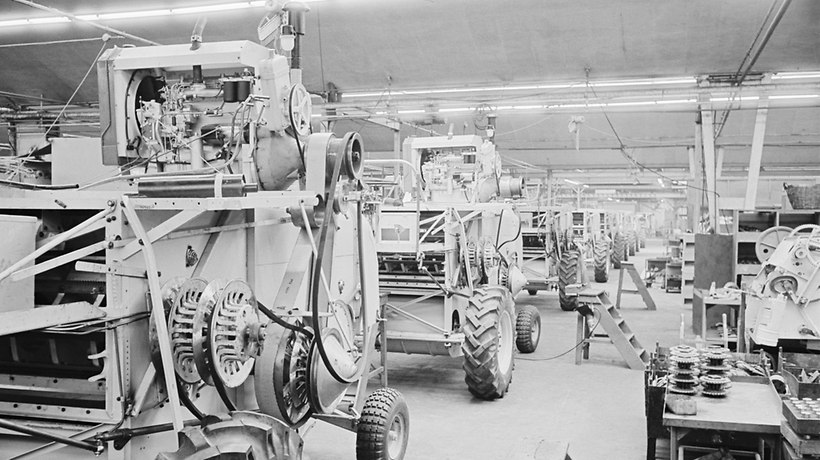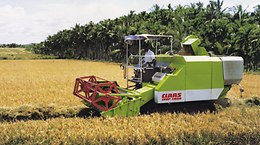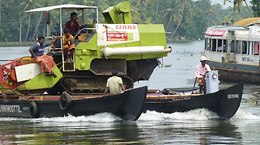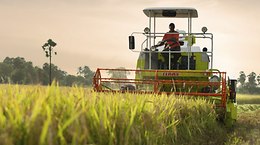

Scaling up to a whole new dimension
With the DOMINATOR, CLAAS entered a new dimension in combine harvester construction. Recent years had seen a trend towards larger farms and areas under cultivation and increased harvest yields, and on many smaller farms people were beginning to realise that they did not necessarily have to do their own grain crop harvesting. Harvesting practitioners were therefore looking for more powerful combine harvesters, which would be more user-friendly for the operator.
1971
On 6 December 1969, the go-ahead was given for the development of a completely new generation of CLAAS combine harvesters – and a pilot run of 100 machines of the new model was ready for action already for the 1970 harvest. The name said it all: DOMINATOR. CLAAS officially launched the DOMINATOR 80 in the five-straw walker class in 1971, followed by the DOMINATOR 100 in the six-straw walker class one year later. The 1.32-m-wide threshing drum in the DOMINATOR 80 (1.58 m in the DOMINATOR 100) opened up the possibility of new dimensions of power and productivity. The DOMINATOR 80 was initially driven by a 105-hp, six-cylinder diesel engine. Unusually, the engine was located directly behind the cab, with the corn tank behind the engine. This had the advantage of keeping the distance between the engine and the threshing drum, as the unit with the highest power requirement, as short as possible. For the DOMINATOR 80, a hydrostatic ground drive system was available as optional equipment. This was a new development in combine harvester construction, where the infinitely variable V-belt variator was still the norm.
The manufacturing process in the plant was also completely transformed for the introduction of the DOMINATOR, by changing over to a module construction approach. This allowed the use of individual assemblies and modules in different models with different widths. The result was a significant reduction in costs, and lower inventories within the production plant.
Along with annual facelifts, more substantial improvements and enhancements were carried out at longer intervals, across the entire model range. These were indicated with changes in the last digit of the model number: The 5 series began in 1975; the first 6 model appeared in 1979, and from 1982 the 8 series was on the market. The DOMINATOR model series held its position on the market for an unusually long period, and for many years was Europe’s biggest-selling combine harvester model. This success can be put down to its versatility, productivity, reliability and outstanding user-friendliness.
1981
CS – high-performance eight-cylinder model
To boost the performance of its large combine harvesters, in the CS combine harvester CLAAS replaced the straw walkers with a “cylinder system” (CS) with eight separating cylinders. The new system was first launched in 1981 in the DOMINATOR 116 CS. This machine continued to use a threshing drum (1.58 metres in width). Eight separating cylinders were located behind the drum with separator concaves positioned underneath. The purpose of the concaves was to separate as much grain as possible from the straw. The separating cylinders took up the straw and transported it by a positively controlled process to the straw bonnet. This method of conveyance ensured a uniform crop flow. The grain itself could be separated very effectively from the thin straw layer. Both the concave gap of the separator concaves and the speed of the separating cylinders could be adjusted to suit the crop type. From 1986, the CS machines were renamed COMMANDOR to better distinguish between those with straw walkers and those featuring the cylinder system. The expensively produced system never quite made it onto the market, despite having set a harvesting world record with the CLAAS COMMANDOR in 1990 with 358 tonnes of harvested wheat in eight hours. Combine harvesters with the CS system continued to be manufactured until 1995.
| Product | Brochure |
| DOMINATOR 116 CS | Download |
| COMMANDOR 116/115/114/112 CS | Download |
1992
CROP TIGER – compact all-rounder
In many parts of the world, cropping is still being carried out on very small land areas. To ensure economically efficient, minimal-loss harvesting, CLAAS developed the CROP TIGER. Development of the CROP TIGER was begun in the early 1980s. The objective was to develop a small machine for rice harvesting, in particular for the Asian market. Originally, the CROP TIGER produced in India was conceived for the particular conditions of rice harvesting. Through continuous refinement, however, the machine can now also be used in grain crops with comparable efficiency.
1993
MEGA – greater output with APS
The CLAAS MEGA is based on the famous DOMINATOR; the hallmark of the new models is the MEGA threshing system. It consists of the traditional CLAAS threshing system, enhanced by the accelerator with its own pre-cleaning concave. The upstream accelerator drum equalises the crop flow and ensures that the machine runs smoothly in irregular conditions. Loose and easily threshable grain is separated by the concave before reaching the threshing drum. The MEGA threshing unit improved the operation of the threshing unit and eased the load on the straw walkers behind. With the MEGA system, it was possible to enhance throughput by up to 30 percent.













